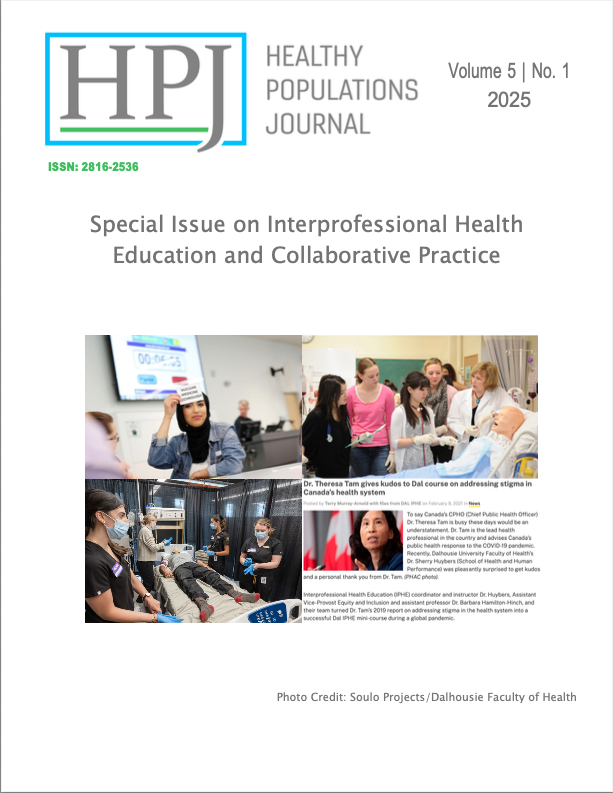Welcome Letter
Abstract
Welcome from the Co-Editors-in-Chief
We would like to welcome you to volume 5, issue 1 of the Healthy Populations Journal (HPJ), a special issue on Interprofessional Health Education and Collaborative Practice (IPHECP) sponsored by the Centre for Learning and Teaching (CLT) at Dalhousie University. As a student-run, open-access, peer-reviewed journal, this issue brings together IPHEC both in content and in practice where an interprofessional guest editorial board learned about the peer review process during the publishing of this issue. You can read more about the editorial experience in CLT’s blog FOCUS.
Articles in this issue are written from student perspectives and experiences working in interprofessional settings as student healthcare professionals, present original results from interprofessional research and outline review protocols as a common research methodology used to bring together large bodies of knowledge that can inform interprofessional research and practice. Developed in a community based, interprofessional setting, Liepert et al. infographic increases the accessibility of research findings for healthcare providers, frontline shelter workers and community members with diabetes understand and manage symptoms and health impacts. Two commentaries raise awareness about the role of community-based interprofessional teams that also support student training. Ayoub et al. highlight the Halifax Outreach Prevention Education Support (HOPES) clinic, a student-run clinic offering services from 8 different health disciplines to populations who may otherwise not have access to such care. Dunbar Wilson et al. show how community efforts can lead the way for access to diagnoses support for individuals with FASD in rural Newfoundland. This issue presents three review protocols aimed at advancing IPHECP. Valuing IPHECP as a pedagogical tool, Van Dam & Price outline a protocol aimed at exploring the role of IPHECP in training pre-licensure dentistry and dental hygiene students to understand their professional role and identity. The ways in which the presence of an interprofessional healthcare team influences caregivers of pediatric patients to present to an emergency department is an important question that can inform the structure of pediatric healthcare teams in general (Devereaux et al.). McConnell et al. connect a scoping review on evidence-based interventions in kidney transplantation care to principles of IPHECP to assist interprofessional teams in understanding the roles of different professionals. Yusuf et al. engage love letter writing as a post-qualitative framework to evaluate their experiences as PhD candidates/teaching assistants in an asynchronous, online interprofessional course on allyship.
HPJ would not be possible without support from the Healthy Populations Institute and the guidance from the HPJ Editorial Board Members. Particular to this issue, funding through an Anne Marie Ryan Teaching & Learning Enhancement Grant from the CLT. In addition to base issue costs, this grant permitted HPJ to offer guest editors a modest honorarium for their work. A special thank you to the leadership of Dr. Sara Kirk and Dr. Diane MacKenzie, OT Reg. (NS).
We truly hope you enjoy reading volume 5, issue 1.
ivan beck and Joshua Yusuf
Additional Files
Published
Issue
Section
License
Copyright (c) 2025 Healthy Populations Journal

This work is licensed under a Creative Commons Attribution-NonCommercial 4.0 International License.
The journal aims to reduce barriers to publishing and sharing research and inequalities to accessing information.This journal provides immediate open access to its content on the principle that making research freely available to the public supports a greater global exchange of knowledge. The open-access nature of the journal means that there will be no charge for authors or readers to use the journal. The journal has a Creative Commons Attribution Non-Commercial (CCBYNC) attribution which allows the author (and others) to share and distribute their full-text article in other public domains, such as Google Scholar or Research Gate.

